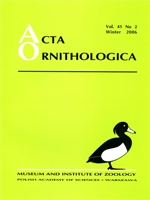This paper examines the first arrival dates of 25 migrant bird species recorded at Portland, Dorset, UK, for the period 1959–2005. To determine if trends over time existed, linear regression of first arrival dates on year was used; initially for the whole period and subsequently separately for 1959–1981 and 1982–2005. First arrival dates were compared to spring temperatures along migration routes in southern Europe and France and in the UK. The arrival of 11 species (e.g. Sand Martin, Blackcap and Pied Flycatcher) was significantly earlier with the mean trend for all species showing an advance of 1.6 days/decade over the study period. Over all species, trends in first arrival date were not significantly different between the two time periods but there were differences for Turtle Dove, Whitethroat and Lesser Whitethroat. Monthly mean temperatures along the European part of the birds' migration route were generally negatively correlated with, but can only explain < 30% of the variability in, first arrival dates. The consequences of both a changed phenology and differential phenological changes between species require urgent investigation.
How to translate text using browser tools
1 December 2006
Trends and Temperature Effects in the Arrival of Spring Migrants in Portland (United Kingdom) 1959–2005
Philip J. Croxton,
Timothy H. Sparks,
Martin Cade,
Richard G. Loxton
M. Ahola
,
T. Laaksonen
,
K. Sippola
,
T. Eeva
,
K. Rainio
,
E. Lehikoinen
2004. Variation in climate warming along the migration route uncouples arrival and breeding dates. Global Change Biol. 10: 1610–1617. Google Scholar
S. R. Baillie
,
J. H. Marchant
,
H. Q. P. Crick
,
D. G. Noble
,
D. E. Balmer
,
R. H. Coombes
,
I. S. Downie
,
S. N. Freeman
,
A. C. Joys
,
D. I. Leech
,
M. J. Raven
,
R. A. Robinson
,
R. M. Thewlis
2006. Breeding Birds in the Wider Countryside: their conservation status 2005. BTO Research Report No. 435. BTO, Thetford. (
http://www.bto.org/birdtrends
). Google Scholar
C. Both
,
S. Bouwhuis
,
C. M. Lessells
,
M. E. Visser
2006. Climate change and population declines in a long-distance migratory bird. Nature 44: 81–83. Google Scholar
C. J. Butler
2003. The disproportionate effect of global warming on the arrival dates of short-distance migratory birds in North America. Ibis 145: 484–495. Google Scholar
V. Dose
,
A. Menzel
2004. Bayesian analysis of climate change impacts in phenology. Global Change Biol. 10: 259–272. Google Scholar
N. Huin
,
T. H. Sparks
1998. Arrival and progression of the Swallow Hirundo rustica through Britain. Bird Study 45: 361–370. Google Scholar
N. Huin
,
T. H. Sparks
2000. Spring arrival patterns of the Cuckoo Cuculus canorus, Nightingale Luscinia megarliynchos and Spotted Flycatcher Musciapa striata in Britain. Bird Study 47: 22–31. Google Scholar
O. Hüppop
,
W. Winkel
2006. Climate change and timing of spring migration in the long-distance migrant Ficedula hypoleuca in central Europe: the role of spatially different temperature changes along migration routes. J. Ornithol. 147: 344–353. Google Scholar
H. Kokko
1999. Competition for early arrival in migratory birds. J. Anim. Ecol. 68: 940–950. Google Scholar
E. Lehikoinen
,
T. H. Sparks
,
M. Zalakevicius
2004. Arrival and departure dates. Advances Ecol. Res. 35: 1–31. Google Scholar
R. G. Loxton
,
T. H. Sparks
1999. Arrival of spring migrants at Portland, Skokholm, Bardsey and Calf of Man. Bardsey Observatory Report 42: 105–143. Google Scholar
L. V. Sokolov
,
M. Y. Markovets
,
A. P. Shapoval
,
Y. G. Morozov
1998. Long-term trends in the timing of spring migration of passerines on the Courish spit of the Baltic sea. Avian Ecol. Behav. 1: 1–21. Google Scholar
T. H. Sparks
,
F. Bairlein
,
J. G. Bojarinova
,
O. Hüppop
,
E. A. Lehikoinen
,
K. Rainio
,
L. V. Sokolov
,
D. Walker
2005. Examining the total arrival distribution of migratory birds. Global Change Biol. 11: 22–30. Google Scholar
T. H. Sparks
,
D. R. Roberts
,
H. Q. P. Crick
2001. What is the value of first arrival dates of spring migrants in phenology? Avian Ecol. Behav. 7: 75–85. Google Scholar
F. Sueur
,
P. Triplet
2001. Réchauffement climatique: les passereaux arrivent-ils plus tôt au printemps? Avifaune Picardie 1: 111–120. Google Scholar
P. Tryjanowski
,
S. Kuźniak
,
T. Sparks
2002. Earlier arrival of some farmland migrants in western Poland. Ibis 144: 62–68. Google Scholar
P. Tryjanowski
,
S. Kuźniak
,
T. Sparks
2005. What affects the magnitude of change in first arrival dates of migrant birds? J. Ornithol. 146: 200–205. Google Scholar
M. E. Visser
,
C. Both
,
M. M. Lambrechts
2004. Global climate change leads to mistimed avian reproduction. Advances Ecol. Res. 35: 89–110. Google Scholar
C. V. Wernham
,
M. P. Toms
,
J. H. Marchant
,
J. A. Clark
,
G. M. Siriwardena
,
S. R. Baillie
(eds).
2002. The Migration Atlas: movements of the birds of Britain and Ireland. T. & A.D. Poyser, London. Google Scholar

Acta Ornithologica
Vol. 41 • No. 2
December 2006
Vol. 41 • No. 2
December 2006
birds
climate change
migration
phenology




